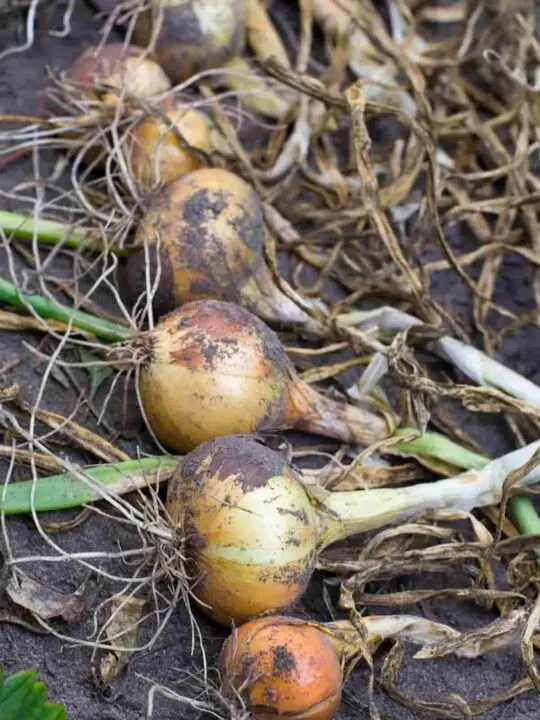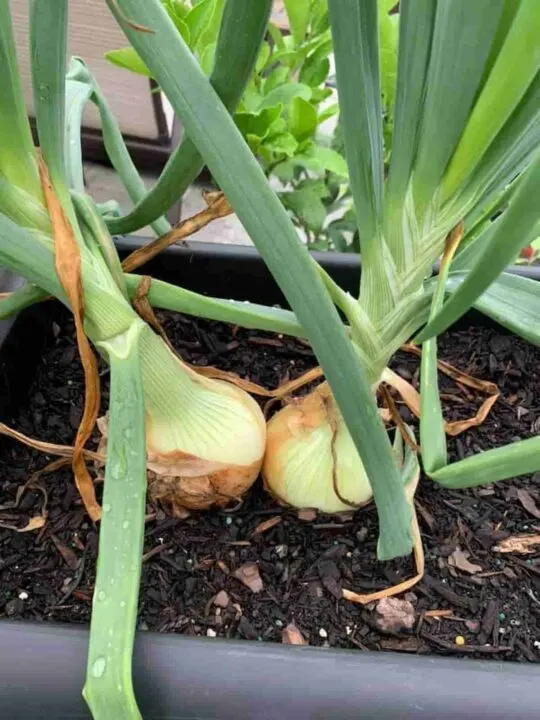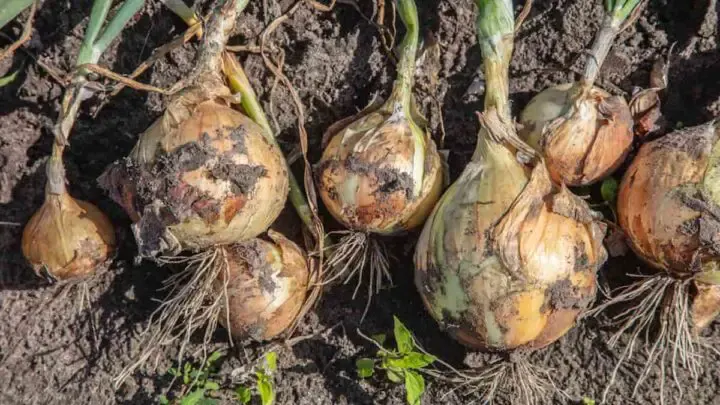Anytime you grow onion plants, it’s truly an adventure. There’s the whole process of planting it deep in the dirt, and then that waiting game for the big bulb to start poking its head. One thing you do start to notice as it grows is those big green leaves sprouting out of the top. Occasionally though, when something goes wrong, you may notice they start browning. But is that normal? Why do onion leaves turn brown?
In most cases, onion leaves turn brown when the onion is reaching maturity and the bulb is forming. However, in some cases, the foilage may have a fungus; usually Alternaria. Poor watering and fertilizer control, as well as pests destroying the onion from the inside, can also be causes of leaves turning brown, or yellowing.
So as you can see, brown leaves are a big no-no when it comes to onion plants. Thankfully, the problem is reversible in many cases. Having had this experience before in my garden, I thought it’d be helpful to share the tips I’ve gathered along the way so that you can have big, green, and healthy-looking leaves on your own onion plants.
Let’s get into it!

Causes Of Brown Onion Leaves
Although browning leaves isn’t always a problem, sometimes it can be. Particularly if your onion isn’t really forming a bulb yet, or it’s happening early in the process. Here are a few causes I’ve identified for brown leaves on onions.
Pests Eating Away At The Bulb And Roots
Onions are a deeply planted vegetable. So for that reason, it’s not always obvious when pests are eating away at them. Sometimes they can infiltrate the bulb itself, eat away at the core, and before you know it, your onion is dying.
The browning of the leaves will start at the base of the bulb and work its way up to the top. The only way to tell is to pull the onion up itself and you’ll likely see holes inside of it. Followed by that will be rotted parts that have been exposed.
In addition to the bulb being eaten out, there are also rootworms that can start damaging the plant this way. When this happens, the worms can stunt the overall growth of your onions.
Wireworms are particularly at fault here. If you suspect wireworms are the problem (or other types of rootworms) then you can try flooding out the soil to get rid of them. Thsi works a bit better in containers than in-ground.
If the problem is particularly bad, then it may be a good idea to transplant your onion altogether to a fresh batch of soil. This is more easily done by soaking the soil until the roots are exposed so that you won’t have cut or damage too many of them.

Root Rot
Root rot is more common than you may realize. It’s a fungal disease that can be present in many soils.
This typically happens when there is poor soil drainage, usually because the soil is too dense or there aren’t enough drainage holes if the onion is in a container.
Root rot can also be caused by overwatering to the point the soil never dries out. The soil stays in a moist state, and the roots can’t soak all of it up. They become waterlogged and eventually start rotting away.
Root rot will not only be accompanied by browning leaves but an onion that begins to appear yellow in color. You may also see some daytime wilting of the leaves.
Underwatering
For those that live in ultra-hot climates, or grow their onions in containers, underwatering could present some challenges. Because onions are grown deep, it’s not always easy to tell if it’s getting the right amount of water.
Thankfully, those leaves that sprout from the top are clear indicators. If they have a nice, healthy green color to them, then you can be confident it’s getting a good amount of water.
On the other hand, if you notice drooping accompanied by browning, then it possibly needs more. You should aim to water your onion plants once per week with at least an inch of water (more if planted in containers).
You can also do a quick soil test by sticking your hand about an inch deep and seeing how moist it is. If you find that layer of soil dry, then it’s time to give your plant an additional watering. Also remember that onion roots usually take up the top 18 inches of soil, so the moisture needs to cover at least that much area.
Underwatering can also be an issue if your onions are planted in the ground, but the area is uneven. Uneven watering not only causes some issues like browning and crisping of the leaves, but it can also cause your onions to split.
Likewise, if your onion is frequently in full, direct sunlight, it may be helpful to move it into the shade or to mulch around the plant so it can retain some more moisture.

Fertilizer Control
Fertilizer control or lack thereof can cause onion leaves to burn. This is especially true if it gets way too much nitrogen. While nitrogen is great for foilage, too much of it during the bulbing stage can cause your onion to grow too fast and die from the built up.
To keep things working well you should:
- fertilize at the correct time (not late)
- choose a balanced fertilizer
Well-balanced fertilizers will have an even mix of NPK. It can be applied every 2 to 3 weeks if it’s a slow release. While they are still in a seedling state, blood meal is a good option as it has more nitrogen. From there go with something like an 8-16-16 mix.
Fungus
Fungus in the soil as well as other bacterial diseases can quickly ravish any plant if it’s not addressed quickly enough.
With onions, this can someone creep up on gardeners.
Think about it, the onion is in the ground and as far as you can see, nothing is wrong with it. However, the moment you see some drooping or discoloration of the leaves, you may need to consider what’s happening in the soil.
Other Causes To Keep In Mind
There are a few more causes to keep in mind when onion leaves start to turn brown. They include:
- Wind
- Excess salt in the soil
- Sun stress
- Humidity
- Onion variety
- Bulb Decay
- Fusarium rot
might seem like it has little impact on the tips of your onion plant browning, but it’s actually the complete opposite.

Remedies For Brown Onion Leaves
While onion leaves turning brown is a concern, it can be fixed in most cases. Here’s what I found to be helpful in my experience:
Plant Your Onions In Shaded Locations
Sun exposure plays a huge role in plants and burned foliage. When it’s too hot out, the leaves can get crispy and die off. Fertilize can help with this yes, but ultimately, the soil is going to dry out too quickly. This leads to stressed roots, and before you know it, your onion plants will have more issues than just brown leaves up top.
Plant them in partly shaded areas, or areas that only get a certain amount of sunlight. It may even help to place a mesh cover over your onion plants to cool down the temperatures a bit.
Test Your Soil Regularly
Overfertilizing tends to happen a lot with onions. It’s not surprising though. Because the roots travel about 18 inches deep, they can be tough to properly supply with nutrients. Compost tea works well as long as it’s balanced, but I still recommend slow-release fertilizers to avoid burning the plant.
Ultimately, testing the soil is going to help you make better decisions with your plant. There are plenty of cheap soil kits you can find that will give you all types of readings so you can understand the health of that soil.
I would test regularly and adjust your fertilizing based on those results. Generally speaking, not as much nitrogen is needed once the bulb starts to form.
For more general onion growing, try to keep the soil pH levels between 6.0 – 7.0 at most. If it’s too acidic, you’ll have problems. High levels of organic matter are also helpful for optimal onion growth.

Hi there, my name is Allie and welcome to my blog; GareningWithAllie!
Much of what you see written here is just our personal experiences with gardening. Along with the content I write here, there is also a unique collection of gardening topics covered by some of our close friends. I hope you find everything you read here to be helpful, informative, and something that can make your gardening journey the most lovely experience ever! With that said, Happy Gardening!
